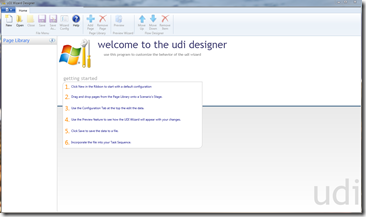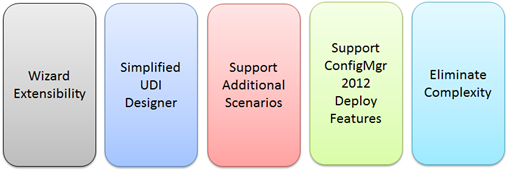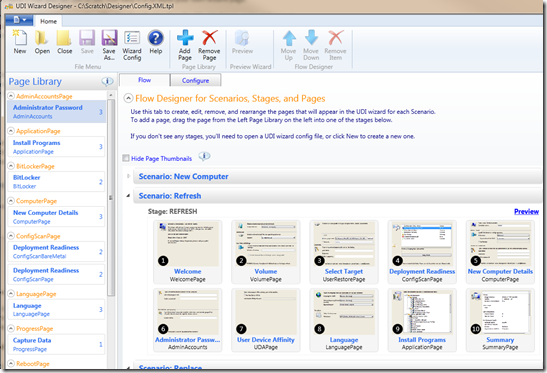MDT 2012 Beta 2–User-Driven Installation (UDI) Version 2
Since the release of MDT 2010 Update 1, our User-Driven Installation (UDI) engineering team has worked extremely hard at making the use of UDI much simpler for administrators and end-users to use. This is the founding principle, or pillar, we focused on this past year. This hard work of our team was made available to you in Beta form last Thursday.
Today, I wanted to spend a little bit of time talking to you about the key areas that we spent significant amounts of engineering effort on with the goal of enhancing current UDI users, as well as net new one’s, experience. MDT 2010 Update 1’s UDI was singular in it’s purpose – build all the functionality necessary to allow administrators to build a replace scenario experience that interacts with end-users. This included building a administrative designer, UDI Designer, as well 8 or so “pages” that could ask end-user questions and take the appropriate steps to change the Windows deployment.
Driving MDT 2012 UDIvNext: What to invest in?
The MDT team spent a lot of time trying to understand what customers wanted from UDIvNext. This included having face-to-face conversations with various individuals and companies. It included interacting with some customers via blogs and email. It also included working with our internal partners such as Microsoft IT.
In the end, MDT 2012 UDI’s engineering investments came out across five pillars -
Wizard Extensibility
in MDT 2010 Update 1’s UDI, our team built pages focused on the most “common” information asked of end-users and offered administrators the ability to disable entire pages, or lock specific parts of the page so that end-users don’t interact. This was useful if you agreed that the most common information comment – which we knew was an engineering trade-off of meeting deadlines.
We knew that given the opportunity our team had to spend time re-engineering the UDI Wizard to be fully extensible. By extensible, we mean that with minimal development effort you can build your own pages for your end-users to interact with. In fact, we delivered a sample with MDT 2012 Beta 2 that you can use to see how easy it is to build your own wizard page.
As a second piece to extensibility, we wanted to take away the difficulty of understanding the “disable” logic and just focus on building an experience whereby pages were shown only if in the configuration. Thus, in UDIv2, you will see that we removed disable and the way that you do this functionality in v2 is to simply remove the page.
UDI Designer Extensibility
Yes, in MDT 2012 Beta 2, we made the UDI Designer a fully extensible platform that allows our customers to build not only wizard pages but also experiences within the designer making it easier for deployment admins to configure the newly created pages. This makes it super compelling because you can now build your own experience and have those pages configured right next to the pages that ship as part of UDI.
KISS: Re-building UDI Designer
The MDT 2010 Update 1 UDI Designer experience was, well, an average experience. It certainly simplified the experience for creating configuration but it didn’t follow the principle of “KISS” (Keep it simple, stud – um, changed to be politically correct!) and our engineering team knew it. In MDT 2012 Beta 2, you will see an all new UDI Designer built from the ground up that supports all the functionality of v1 but in a easier to use method.
 This designer supports a lot of the innovation that is part of MDT 2012 UDI and supports the pillars listed above. For example, the Page Library is built as a list of “pages” that are available from Microsoft as well as any others that have been added. In a future post, we will share with you our details on how you can easily obtain and share your pages with the rest of the world.
This designer supports a lot of the innovation that is part of MDT 2012 UDI and supports the pillars listed above. For example, the Page Library is built as a list of “pages” that are available from Microsoft as well as any others that have been added. In a future post, we will share with you our details on how you can easily obtain and share your pages with the rest of the world.
As part of this design, we allow you to edit configuration stored anywhere including on SMB file shares. This means that the UDI Designer configuration, the entire configuration, can be stored remotely and utilized. This is different than in MDT 2010 Update 1as we only supported applications stored remotely.
The MDT 2012 UDI Designer also provides you the ribbon experience that is so common across Microsoft applications today. These provide contextual access to common tasks, as well as, the traditional right-click experience. For Configuration Manager (ConfigMgr) administrators, the ribbon is added in the Admin console so we wanted to stay closely aligned here as well.
Provide Additional Scenarios: Add New Computer, Pre-Stage Media, and Refresh Scenarios
As I mentioned earlier, MDT 2010 Update 1’s UDI provided a single scenario for UDI. This meant that unless you were replacing your PC you couldn’t take advantage of UDI. In MDT 2012, we wanted to provide UDI support across other key deployment scenarios. This includes the MDT New Computer, as well as Pre-Staged Media, and lastly the refresh scenario.
This means you can utilize a user-driven experience for a brand new computers, or with computers sent directly from OEMs using Pre-staged media, and lastly you can offer the ability in refresh scenarios to gather key information from old machines such as applications installed, user state & configuration, and store them for restore on the new PC.
This is super valuable because it offers the ability for end-users to control where their configuration is stored, and re-stored. In MDT 2012, we encrypt the data so that USB drives can have multiple users data on it without any end-user (or administrator for that matter) seeing the data. At an internal customer, this was used for 5000+ hardware refreshes and worked flawlessly.
ConfigMgr 2012: Using Applications at Provision Time
UDI, as you know, requires Configuration Manager 2007. In MDT 2012 Beta 2, we’ve added full support for UDI with Configuration Manager 2012 and this means support for the newly created powerful Application Model. This means that at provisioning time your end-users can select to install both packages/programs (Classic) and Applications. The magic here is the end-user is abstracted from having to know where an application resides, it just happens automatically using MDT 2012 UDI.
The only step to ensure you’ve done (and we will cover in later blog posts) is to click Configuration Manager ribbon item to set your settings. We will detect the version of Configuration Manager and, if 2012, you will be set to support Classic software packages as well as new Applications.
Beyond this, in this version, this is the first UDI to support the Pre-staged Media feature that shipped with ConfigMgr 2007 R3. This is natively supported and allows you to configure a UDI experience that occurs on a new machine sent directly from the OEM.
Confusion: Eliminate it & Simplify
Without a doubt, the UDI feature team never wants to ship anything that confuses end-users or administrators. We received a lot of feedback from you that the need for Internet Information Services (IIS) 7.0 and SQL Server was very confusing. A great number of you were unsure how these two were needed for a deployment of UDI and you are mostly right. In a great deal of scenarios, you don’t need it at all – hence the complexity.
In MDT 2012 Beta 2, we’ve removed this requirement altogether. The storing of a configuration centrally is still supported but is natively built-in to MDT 2012 task sequence thus meaning that the UDI Wizard configuration can be obtained locally (in the ConfigMgr package), on a SMB File Share, or even on a Web Server. This isn’t required though for any scenario and is completely up to the administrator. The flexibility of storing the configuration remotely is super important and we wanted to fully support it but not at the expense of you having to use additional hardware.
Download MDT 2012 Beta 2 Today: Give Us Feedback!
The bits are alive and ready for you to take and start testing your deployments using MDT 2012 Beta 2. We’d love if you would give UDI a try and be super excited to take your feedback. In the next couple of weeks, I will do some more in-depth posts that go deeper on getting started with UDI in MDT 2012 Beta 2. For now, though, we are in hopes that you will give it a shot as we believe that we’ve made it simple enough for you to kick-off without any help. If this isn’t the case, please share that feedback as without you we don’t know what you want!
Summary
I’m super pleased with our engineering team for taking on aggressive plans for MDT 2012 and executing strongly against them. This includes hard work done by many people including Cameron King, John Socha-Leialoha, and Michael Niehaus. I only call these out as they each have a personal blog but trust me when I say that UDI is a huge undertaking and I’m super proud of our team.
As I mentioned above, we focused this update on 5 key pillars and all the changes we made went across one of those five pillars. We used these pillars as a guiding principle across the board and if anything was outside these pillars we cut it. We wanted to be consistent in our changes and we wanted to focus on a few things and drive them completely rather than doing a lot of little things and not fully completing them all. Give it a start today…
Enjoy!
Thanks,
-Chris



